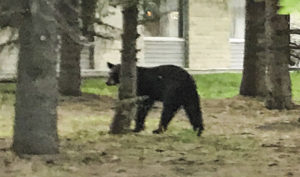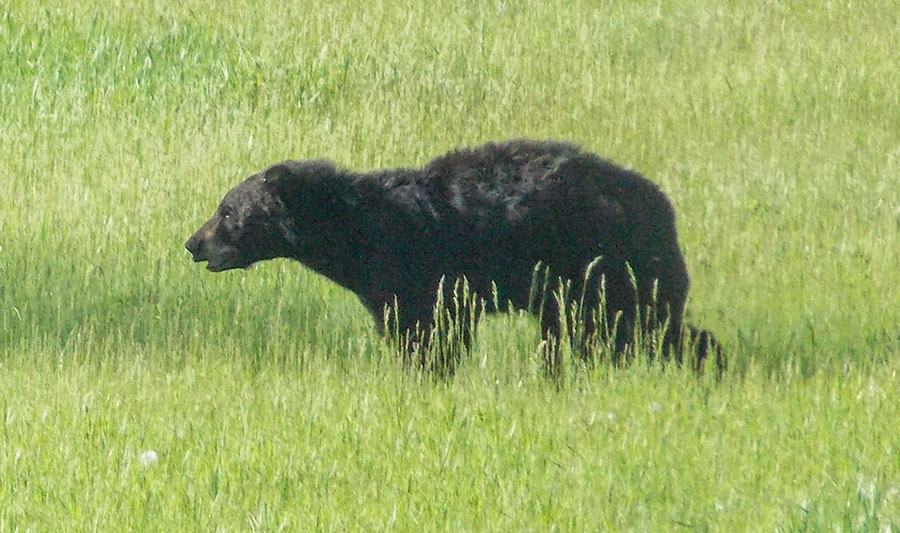
BY KIM LANGEN
When a local taxi driver witnessed a black bear barrelling along Broadway early Saturday morning, he couldn’t believe his eyes.
“It was 5:45 a.m., and I just happened to glance up near Blair Pugh’s place, at the corner of Tupper and Broadway,” said early riser Jim Charles, who covers a dawn taxi shift. “The bear ran out of the hedge by Blair’s and his neighbour’s place. He was crossing Main Street, and I almost hit him. I was maybe 10 feet away. He was just givin’ ‘er. I had to hit the brakes. I thought it was a big black dog.”
Charles was on his way to pick up bakery worker Iona Patterson, who was due to start her bake shift at 6 a.m.
He didn’t want her to be late for work, but a rare bear on Broadway is not something you get to see too often.
So Charles decided to draw her into the early morning drama.
“The bear went onto the sidewalk on the east side of Broadway, and then he turned and ran through Doug Tripp’s yard,” said Charles. “That was funny, because that’s who I work for. That was when I took off to pick up Iona, and when I got there, I told her to jump in. I said, ‘Get your camera ready. We’re going to see a bear.’”
Patterson was at that moment outside, taking a picture of the beautiful sunrise, she said, when Charles pulled up.
Charles says he had kept watch on the fast-moving bear in his rear view mirror, to see what direction it would take.
“It was crossing Park Street, and going south, heading towards the hospital,” he said. “I got ahead of him near the hospital, and cut him off. I stopped the taxi, and the bear looked right at us. Iona held up her camera phone, and took four or five pictures.”
Patterson caught the shots of the bear through Charles’ open taxi window, near the parking lot.
“He was hiding behind one of those trees in front of Bayside,” she said. “I think we had tired him out.”
The bear then passed by the windows near the Emergency entrance, he said, past Bayside, and then out into the green area near the highway.
The last the bear-stalking duo saw of the bruin was when the bear hit the corner of Park and #18, heading east towards the Ramsden’s corner field of cattle.
“He hadn’t crossed the 18 yet, but that’s where he was heading,” said Charles. “Doug Tripp told me later that a bear had been spotted near Cartwright on the weekend. That will probably be the one leaving here.”
Bears are omnivores, and during these early summer days they are feasting mostly on dandelions and grasses. They eat more vegetation than they do meat or carrion, and also enjoy berries and fruits.
Charles says he’s seen a lot of bears up north, but they are a rare sight in this area. They’re much faster than people expect, and can outrun a horse, he said.
“I drive the taxi from 5 a.m. until 8:30 a.m. for Doug,” he said. “I have seen moose in town, I’ve seen coyotes in town, but never a bear. This was a young black bear, maybe a yearling. It was kind of funny. We were a little excited.”
“It was definitely an adventure,” said Patterson, who bakes bread and buns and decorates cakes at the local Co-op Food Store. “I’ve seen bears before, when I was camping, but never that close. And was I late for work? No. I was one minute early.”

PEEK-A-BOO BEAR – This black bear, who passed through Killarney very early on Saturday morning, was captured briefly on camera, trying to hide in the trees by the Tri-Lake Health Centre. Taxi driver Jim Charles and passenger Iona Patterson managed to catch up with the fast-moving bruin just before he left town – and Patterson barely had time to snap the photo.
IONA PATTERSON/PHOTO
Black bears on main streets –
looking for love, or just a quick bite?
BY KIM LANGEN
Manitoba Conservation officer Dawson Keen, along with Glen Cassie, Public Affairs Specialist with Communications Services Manitoba, came up with some great information about the world of black bears for us – and what to do if you accidently meet one on Broadway.
Here’s their background on all things bear-related.
Some of the answers may surprise you!
How common is it for bears to pass through the main streets of towns like Killarney?
It is not common for a black bear to visit the more populated areas (such as the main street) of a community in southwest Manitoba, but it does happen from time to time.
There have been bear sightings around the town of Killarney for the past four or five years in May and June. This is the first report of one coming into town in 2018.
Spring is the breeding season, and during this time male black bears will roam further in search of mates. Environmental conditions also play a factor in how much bears move. When conditions are dry, like they have been this spring, bears may have to cover more ground to find food.
What’s the rough population of black bears in the southwest area of the province?
It is hard to estimate the population in this area, because it is not the primary range for black bears.
Killarney is in the centre of the Boissevain District, which is approximately 6,700 square kilometres, and the District office gets about five calls every year for bear sightings.
What do they eat at this time of year?
Once bears emerge from hibernation they are very opportunistic feeders, and will eat whatever vegetation is available, and will feed on carrion from winterkilled animals. Once things start to green up, a black bear’s diet will be about 85 per cent vegetation, including grasses, tree buds, flowers, acorns and berries. If the opportunity presents itself, bears will kill and feed upon newborn deer, moose and elk.
Do they usually travel solo? And what is their usual range area?
Bears are usually solitary animals, with the exception of breeding season and when a female (sow) is with her cub(s). A sow may keep or stay with her cubs for up to 18 months before they become fully independent and go out on their own.
What do you do if you see a bear? If anyone sees a bear, the best plan of action is to leave it alone and report it to your closest Sustainable Development Office.
Do not approach the bear, as you could provoke an aggressive response.
If you encounter a bear on foot, speak calmly, raise your arms in the air and slowly back away. Do not run or climb trees.
To prevent conflicts with bears and other wildlife, it is best to remove any attractants, such as bird feeders, and regularly clean barbecue grills. Feed pets indoors, and store garbage inside when possible.
If a bear does pass through your area, but finds nothing to eat, it will keep moving.
Should I give a bear something to eat? Never feed bears.
Who do you call if you see a bear? To report a bear sighting to a conservation officer, the phone number for the Department of Sustainable Development in Boissevain is 1-204-534-2028.

JUST PASSING THROUGH IN 2014 – Ron Dunn snapped this picture of a black bear near his home at 785 Norquay Avenue at about 6:30 p.m. on June 16, 2014. The local RCMP reported that the bear was just passing through Killarney and heading north.
PHOTO/RON DUNN

